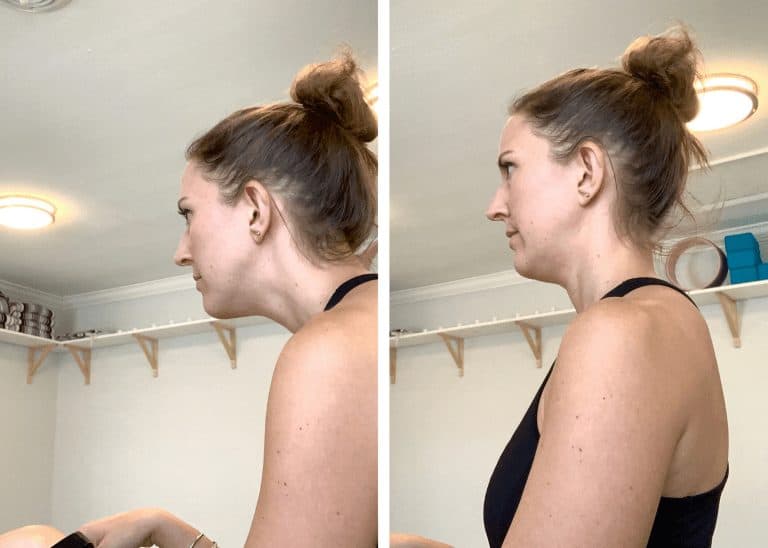Tech neck is what we call it when sitting in front of a computer (or on your iPhone, or behind the wheel, or holding a baby) causes your shoulders to round forward and your neck to freaking. hurt. It can also create headaches, contribute to TMJ, and play a role in a ton of other aches and pains.
Why Your Neck Hurts So Dang Bad
First, let’s talk about why your neck hurts in the first place.
So. You have a spine. Still with me?
Your spine has natural curves in it. Naturally, your low-back and neck curve inward, or anteriorly. Meanwhile, your thoracic spine (rib cage) and tailbone curve outward or posteriorly. These curves are great! They give your spine the ability to move and sustain impact. Without them, activities like running might totally collapse the discs between your vertebrae.
However, the curves of your spine have a sort of ideal amount of curvature. If one curve is off, it’s going to express itself up or down the spine elsewhere. This is because, no matter what, your system is going to keep you upright with your eyes looking out in front of you.
So, when you sit or slouch back in a chair and your tailbone tucks so far under that your low back curve is flattened, the whole spine starts rounding in on itself. Picture your spine like the arc of a crescent moon. However! Your brain is going to keep those eyeballs looking forward. Meaning that your neck is going to have to WAY overarch in order to look forward. In other words, when your chest rounds in, your neck has to overcompensate to keep you looking forward.
The position of the arms and bracing in the chest contributes, too. Even if your low-back is in beautiful alignment, in all of these postures — on your phone, your computer, holding a baby — your arms are reaching forward and probably bracing to some extent. Notice: when you’re typing on your phone or nursing your baby, are you unconsciously tightening the front of your shoulders and chest? This creates more rounding forward in the upper back, which, again, your neck will have to compensate for.
I want to also note that this forward rounding in the chest is almost always exacerbated by having heavier breasts. Either just because you’re naturally that way, or because you’re pregnant or nursing, and are carrying around heavier cups than you’re used to. I’ve heard the same complaint about implants as well.
Lastly, when looking down at a device or baby, your head often moves forward. When your head is stacked directly over your torso, it feels relatively light, and is easy to turn and maneuver. When it comes forward, it suddenly feels much heavier to the neck muscles. Imagine stacking a book directly on top of a pile of other books versus placing the book off to the side, hanging halfway off the rest of the stack. If your head is that topmost book, your neck is having to work much harder to hold it up.
What to Do for an Achey Neck
It might seem like massaging and stretching is the answer, but if you’ve been around here any amount of time, you know I’m going to tell you it’s more than that.
- Sure, you can go ahead and start by massaging the neck. I like to do this lying down with the head supported by the floor or a pillow so it is pain free. Then use two fingers right under the base of the skull to gently press and drag downward, kind of like milking a cow (sorry, I know it’s weird). Repeat that milking movement down the back/side of the neck on each side.
- Then practice turning your head gently to each side. Allow the head to turn all the way to one side, then bring a hand up to the side of the head and gently massage around the jaw and temple areas. Repeat to the second side.
- Address your posture in some of the positions you’re in most often. This may mean adding a lumbar support to your car seat or desk chair. Another trick to get the spine toward neutral is sitting further forward, and upright on top of your sit bones instead of your tailbone. This will automatically move your spine into better alignment (you might need to take more frequent breaks while you get used to it). And make sure that when you’re looking at your screen, the screen is at the height of your gaze without having to drop your head and your head is back with ears stacked over shoulders.
- Most importantly, you want to build up strength between the shoulder blades. Head here for a list of shoulder blade and upper back exercises to try. If you get your shoulders to consistently stay back where they belong, you’ll drag your head forward less.
If you’d like more help addressing sources of chronic pain, I’d love to set up a wellness consultation with you!


